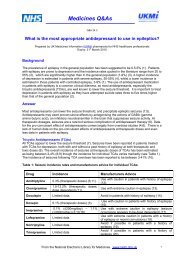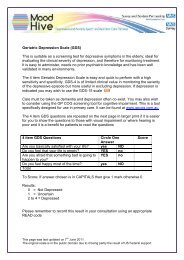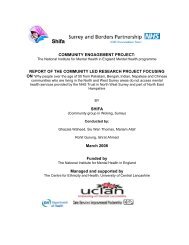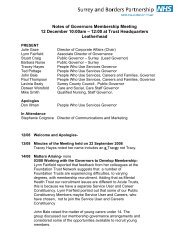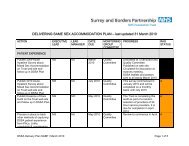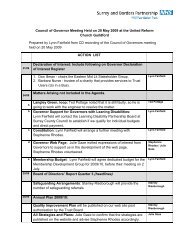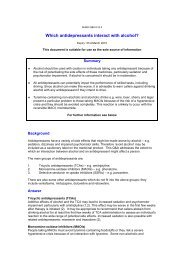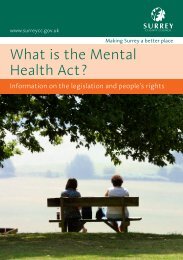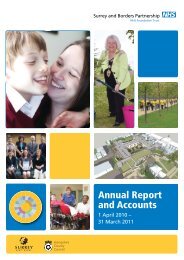Here - Surrey and Borders Partnership NHS Foundation Trust
Here - Surrey and Borders Partnership NHS Foundation Trust
Here - Surrey and Borders Partnership NHS Foundation Trust
You also want an ePaper? Increase the reach of your titles
YUMPU automatically turns print PDFs into web optimized ePapers that Google loves.
Research Method<br />
The study was conducted in our local<br />
Primary Mental Health Care Team<br />
(PCMHT) which is a community<br />
psychiatric service that operates both in<br />
GP surgeries <strong>and</strong> secondary care. A<br />
retrospective survey was carried out of all<br />
the patients with affective symptoms that<br />
were referred to the T<strong>and</strong>ridge PCMHT<br />
over a 6 month period between January<br />
<strong>and</strong> June 2008. It was felt that this would<br />
be a sufficiently large sample to accurately<br />
<strong>and</strong> validly assess the efficacy of screening<br />
for BPD in our catchment area.<br />
Table 1: Proforma used to analyse case records<br />
These referrals came from local GP<br />
surgeries, through the Crisis Advisory<br />
service, the Home Treatment Team <strong>and</strong><br />
following discharge from the inpatient<br />
psychiatric unit at Epsom General<br />
Hospital. Some of these referrals also had<br />
a further triage assessment by a Mental<br />
Health Nurse Practitioner (MHNP) before<br />
being referred to the psychiatrist for<br />
confirmation of their diagnosis.<br />
We examined all patients’ records using<br />
an audit proforma that looked at the<br />
following parameters:<br />
GP assessment MHNP assessment Psychiatrist<br />
assessment<br />
Did the<br />
patient have<br />
2/more<br />
episodes of<br />
mental<br />
illness?<br />
Did the GP<br />
screen for<br />
hypomania?<br />
What<br />
diagnosis<br />
did the GP<br />
propose?<br />
Did the<br />
MHNP<br />
screen for<br />
hypomania?<br />
What<br />
diagnosis<br />
did the<br />
MHNP<br />
propose?<br />
Final<br />
Diagnosis<br />
Research <strong>and</strong> Audit<br />
On completion of the proforma’s the data was analysed using the SPSS statistical<br />
package.<br />
The Psychiatrist’s diagnosis was used as the gold st<strong>and</strong>ard next to which the other<br />
proposed diagnoses were measured for accuracy.<br />
Results<br />
Between 01/01/2008 – 30/06/2008 there were 58 patients referred to the T<strong>and</strong>ridge<br />
PCMHT that presented with affective symptoms. Seven records could not be retrieved,<br />
subsequently 51 patients were included in the audit.<br />
The demographics of our study population were as follows:<br />
Table 2: Demographics of study population<br />
Gender<br />
Age<br />
Male, N = 19<br />
Range, 19 – 62 years<br />
Female, N = 32<br />
Mean = 37.6<br />
(normal distribution)<br />
Out of the 38 patients referred by their GPs, 21 (55.3%) had had two or more<br />
episodes of mental illness whilst for 17 patients (44.7%) it was their first episode of<br />
mental illness. 13 patients were referred from other sources. In these cases the initial<br />
referral letter was analyzed in the same way as a GP referral <strong>and</strong> if they were also seen<br />
by a MHNP, this data was also included.<br />
<strong>Surrey</strong> <strong>and</strong> <strong>Borders</strong> Online Journal www.sabp.nhs.uk/journal 11



